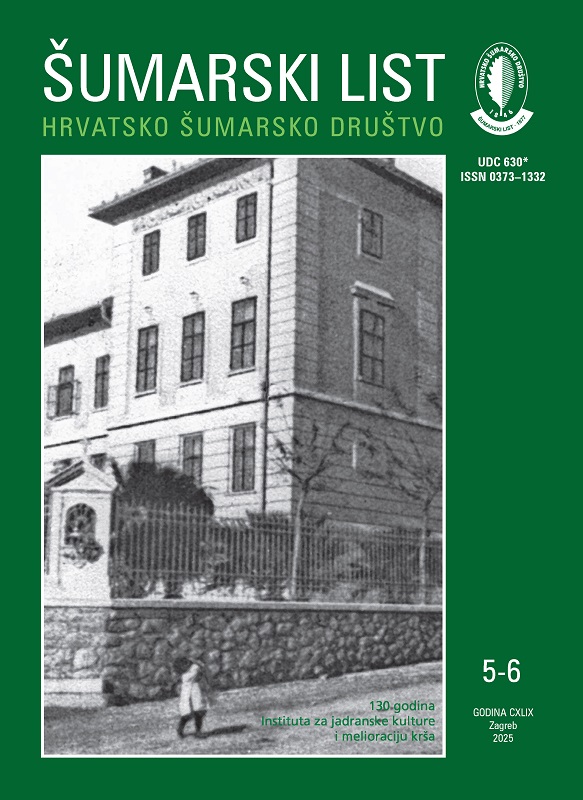| |
| RIJEČ UREDNIŠTVA |
| |
|
|
| Uredništvo HŠD | |
| Should we be surprised by the higher export of timber than furniture from Croatia?
pdf
HR
EN
|
217 |
| |
| IZVORNI ZNANSTVENI ČLANCI |
| |
|
|
| Tatjana Mandić Bulić, Marilena Idžojtić | UDKps://doi.org/10.31298/sl.149.5-6.1 |
| Woody plants of the Brijuni national park
pdf
HR
EN
|
219 |
This study provides an inventory and analysis of the woody plants of the Brijuni National Park, examining both autochthonous and allochthonous taxa recorded in 2021 and 2022 on the islands of Veli Brijun, Mali Brijun and Krasnica (Vanga). The analysis includes data on the number of taxa, family affiliation, distribution range, growth form, leaf persistence, as well as unique, relatively rare, and invasive taxa found in Croatia. A total of 228 woody species, subspecies, varieties, cultivars and hybrids were recorded, of which 27 belong to gymnosperms from 13 genera, while 201 are angiosperms from 128 genera. The Rosaceae family has the highest number of genera, followed by Lamiaceae, Asparagaceae and Cupressaceae. The genera Prunus and Ficus have the highest number of taxa. Regarding growth form, trees are the most dominant, while evergreen taxa prevail in terms of leaf persistence. None of the recorded taxa are unique to Croatia, although eight are relatively rare in cultivation. Only one strictly protected plant species in Croatia, the common yew (Taxus baccata L.), was recorded in the Brijuni National Park, along with two invasive species: tree of heaven (Ailanthus altissima (Mill.) Swingle) and black locust (Robinia pseudoacacia L.). Based on the available literature and this study’s findings, a comparison was conducted between the current woody plant diversity and historical records from the beginning and end of the 20th century. The results reveal significant changes in the woody flora over the course of more than a century. Overall, this research offers valuable insights into the diversity and dynamics of the Brijuni National Park’s dendroflora and highlights the importance of the ongoing monitoring efforts.
|
| Esmera Kajtaz, Dženita Alibegić, Haris Nikšić, Željko Španjol, Boris Dorbić | UDKps://doi.org/10.31298/sl.149.5-6.2 |
| Determination of antioxidant profile of the essential oil and extract samples obtained from lavender (Lavandula angustifolia Miller)
pdf
HR
EN
|
233 |
| Ayşegül Tekeş, Serkan Özdemir, Candan Aykurt, Serkan Gülsoy, Kürşad Özkan | UDKps://doi.org/10.31298/sl.149.5-6.3 |
| Species distribution modeling of red hawthorn (Crataegus monogyna Jacq.) in response to climate change
pdf
HR
EN
|
243 |
| Ali Bayraktar, Deniz Güney, Fahrettin Atar, Ibrahim Turna | UDKps://doi.org/10.31298/sl.149.5-6.4 |
| Evaluation of rooting responses in Lagerstroemia indica L. cuttings under different greenhouse settings, rooting media, and phytohormonal applications
pdf
HR
EN
|
255 |
| Hediye Aktaş Aytepe, Ali Kavgaci | UDKps://doi.org/10.31298/sl.149.5-6.5 |
| Syntaxonomical contribution to the vegetation classification of Türkiye from SW Anatolia: a plant diversity hotspot
pdf
HR
EN
|
265 |
| |
| PREGLEDNI ČLANCI |
| |
|
|
| Igor Anić | UDKps://doi.org/10.31298/sl.149.5-6.6 |
| History of pedunculate oak forest regeneration in Croatia
pdf
HR
EN
|
279 |



